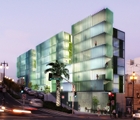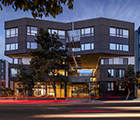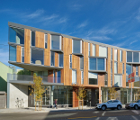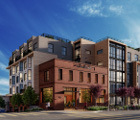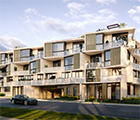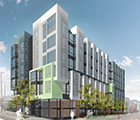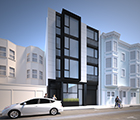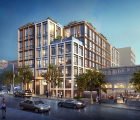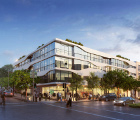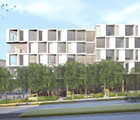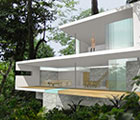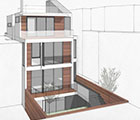PRESS
Read DM Development's latest news and press releases
Lessons Learned From Mission Bay Are Helping Inform Development In Nearby Neighborhoods
New
neighborhoods are rising up around San Francisco, creating vibrant communities of office, residential and retail on previously vacant land. But for areas like Mission Bay, what ended up getting built was far from what was originally conceived, panelists said during Bisnow’s recent Future of SoMa, Mission Bay and Dogpatch event.
Flexibility of design and community engagement have been successful methods that developers have used at Mission Bay as well as emerging neighborhoods of Dogpatch and the Potrero Power Station.
Mission Bay had a master set of approvals that came with aggregate density instead of a block-by-block prescriptive approach that allowed for flexibility within the plan, Mission Bay Development Managing Principal Seth Hamalian said. Mission Bay Development was the master developer of the neighborhood.
The area also benefited from its immense waterfront and infrastructure that was built early on, Hamalian said. He said the city had the foresight of putting in five stops through the neighborhood when it extended the light rail years ago.
He said for every dollar of property taxes collected in Mission Bay, roughly 60% goes toward infrastructure, 20% goes toward affordable housing and the remaining 20% goes toward typical services. He said having this allocation plan in place after redevelopment dollars that would have gone into the project disappeared allowed for a very ambitious plan.
“A project of that scale does not happen with one builder,” Hamalian said. "You have to have a dozen developers going at the same time. If construction persisted for five decades, it would be miserable.”
Having University of California, San Francisco, as the anchor tenant of the neighborhood helped keep development going, he said. When UCSF first started to develop its Mission Bay campus, it was like no man’s land with little other development and amenities, he said. But 15 years later, UCSF is relocating its headquarters to Mission Bay now that the area has become a center of activity for researchers and teachers.
“As projects suffered through the cycles, UC was always building,” Hamalian said. “When capital comes in, it is reassuring to not be alone.”

When Truebeck Construction co-founder Sean Truesdale began working in the area over 10 years ago, the vision for the neighborhood was completely different than what actually got built.
He said he saw different tenants come in like Gladstone, Pfizer, Nvidia and Salesforce with plans that didn’t come to fruition. A site that was meant for biotech is now being developed into a Class-A office building for Uber.
The neighborhood is adding entertainment features like the Warriors arena, as well as residential, tech and life science, he said.
“It’s a very vibrant area now and a great piece of real estate,” Truesdale said. “It has a great community feel.”
Hamalian said one of the biggest lessons learned at Mission Bay was how to deal with parking. He said instead of integrating parking into residential buildings, he wished the master plan incorporated parking that was a block or two away from buildings.
By having parking a block or two away from a housing project, it activates the sidewalks, which is important for ground-floor retail to be successful, he said.
One of the biggest challenges for the neighborhood was bringing in retailers and the bodies to support that retail, Hamalian said. The organization created Parklab, a team of development, design and urban planning experts, to test different ways to activate this space, such as by bringing in food trucks or creating a soccer field.
He said activating these spaces reinforces retail because it brings together people in a central location, creating more traffic in one area.
Preserving Dogpatch's Legacy

As development moves into Dogpatch, which is just south of Mission Bay, developers have incorporated community engagement and flexibility into their process.
Over the last 20 years, Dogpatch had largely been immune from the major development occurring around the city, but within the last four or five years, the tidal wave of development has finally crashed into Dogpatch, DM Development principal Mark MacDonald said.
In Dogpatch, residents have been more concerned about overdevelopment and development changing the nature of the quaint, historic neighborhood. He said the neighborhood has so much character and grit that the challenge of building new is figuring out how to fit into the fabric of the neighborhood while maintaining the history of the area.
MacDonald said at 815 Tennessee, where the developer built 69 luxury condos, the building previously housed the Bowie Switch Co. where local pioneer Jesse Bowie Jr.’s company built electrical equipment for the West Coast electric grid.
The developer worked closely with a local historian to create Wikipedia pages about Bowie and the building to provide the community with a better understanding of the history and to pay homage to the history of the building. The developer maintained the original brick facade and portions of the building, integrated patent drawings on the walls as part of the interior and commissioned artwork in the lobby that pays homage to the electrification of the West Coast. The building was designed by BDE Architecture.
“We ended up going above and beyond, but it ended up working out. These are the things our buyers appreciate the most ... the history of the building, the character of the building,” he said. “For us what was successful was really listening to what the neighborhood wanted.”

At 950 Tennessee, Handel Architects created a mid-block passage, Handel Architects partner Glenn Rescalvo said. While this meant taking 20K SF out of the building design, it also created something that the community wanted: connectivity. He said what is lacking in many neighborhoods across the city is connectivity within neighborhoods and between neighborhoods.
Rescalvo said infrastructure and movement of people need to be planned out before buildings are built, much like how it was done in Mission Bay, otherwise the city ends up with sidewalks that can’t handle the pedestrian traffic.
“The streetscape is really important to how the city works,” he said. “Urban planning needs to focus a lot more on that.”
Creating San Francisco's Next Big Neighborhood

At one of San Francisco’s newest development sites, Potrero Power Station, the challenge for site developer Associate Capital was to figure out how to incorporate elements that didn’t fit in other developments, such as Mission Bay and Pier 70, Associate Capital partner Enrique Landa said.
He said prior to planning the site, the company went on a listening tour to ask residents what they wanted and what is missing from the area. He said a majority of people said they wanted housing and to not have the community look like Mission Bay.
The company created a plan that includes 2,500 housing units, 1M SF of office/life science space and a 180-room hotel that would be redeveloped from the power station, Landa said. The project will incorporate affordable housing and community spaces as well as 6 acres of parks with a large park in the middle of the project.
“Engage early, engage often and keep working the problem,” Landa said.
He said this development won’t be completed until 2035, so the plan needed to include things that would still be relevant. He said projects like this one need to be flexible.
“The trick is not to predict,” Landa said. “The things that are going to work are a lot of housing and a lot of affordable housing.”
